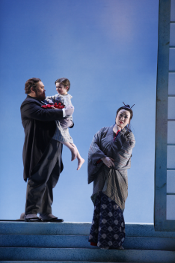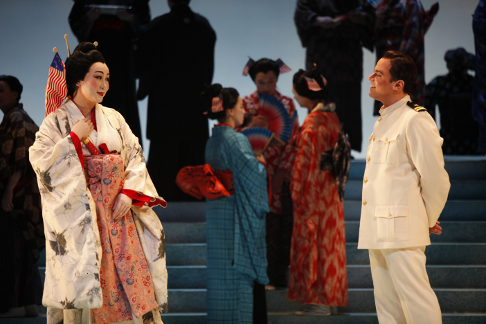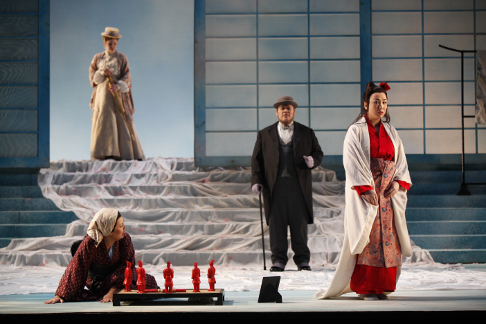29 Mar 2010
Madama Butterfly, NYCO
Once again, as in L’Etoile, Mark Lamos’s staging and Robert Wierzel’s lighting nearly steal the show in the City Opera’s revival of Madama Butterfly.

Once again, as in L’Etoile, Mark Lamos’s staging and Robert Wierzel’s lighting nearly steal the show in the City Opera’s revival of Madama Butterfly.
It says a great deal in her favor that in her sensitive and passionate account of the title role, Shu-Ying Li holds her own against such competition. For example, a great circle dominates the backdrop — red against white for the rising sun or the Japanese flag as the opera opens, turning black against red when the Bonze denounces his errant niece for renouncing her ancestral gods, then white against serene blue for moonlight during the great duet that closes the act.
 Quinn Kelsey as Sharpless, Eddie Schweighardt as Sorrow and Shu-Ying Li as Cio-Cio San
Quinn Kelsey as Sharpless, Eddie Schweighardt as Sorrow and Shu-Ying Li as Cio-Cio San
There are few props on the wide, bare stage, and therefore those we see
possess greater significance. The tiny ancestral gods that Pinkerton scorns as
“dolls” are placed stage center, as on an altar, during later acts
of the story — first for Butterfly to ignore them, preferring the
wide-awake American god, then for her to atone before them by hara-kiri when
she has lost honor, child and everything else. A fleet of tiny red
“warships” floats like a flock of birds above the stage at
curtain-rise — to be echoed in Act II by the toy ship Sorrow plays with.
A telescope is not merely functional, permitting Butterfly to stare at the
empty harbor of Nagasaki, but also symbolizes her undying hopes.
The traditional screen behind which the heroine kills herself does not appear — instead she shows her gumption (and forfeits a pathos playwright David Belasco and composer Puccini both wished to claim) by turning about to slash her throat in her faithless lover’s face, precisely as Pinkerton enters and after his desperate, perhaps repentant cries of “Butterfly!” This confrontational death is an excess. Butterfly, as Belasco and Puccini conceived her, may be a convenient myth, a construction of the guilty Western colonialist conscience, but that is how they created her; to turn her final act into an expression of vendetta, a spitting in the face of her oppressor — the man she has entirely loved hitherto — seems an intrusive modern afterthought. We may have been patronizing when we took Cio-Cio-San to our hearts — but this resentful figure, this image of hate, will not win our hearts at all.
 Shu-Ying Li as Cio-Cio San and Steven Harrison as B.F. Pinkerton
Shu-Ying Li as Cio-Cio San and Steven Harrison as B.F. Pinkerton
Shu-Ying Li has a large and genuine Puccini soprano of great beauty, but there is a certain unsteadiness until it warms up. Her entrance was not luminous, but the duet was, and many other soaring phrases as well. Her Cio-Cio-San was a complete portrait, each line part of the whole, not the collection of pretty excerpts it can become. She is a tall woman and does not move like a small one, and in her enormous wedding kimono she all but dwarfs her Pinkerton, but the robe is soon removed — it is present, hanging on rods, for the rest of the opera, a visible symbol of her past — and in slimmer robes she manages to appear becomingly frail.
 Jessica Klein as Kate Pinkerton, Nina Yoshida Nelsen as Suzuki, Quinn Kelsey as Sharpless, and Shu-Ying Li as Cio-Cio San
Jessica Klein as Kate Pinkerton, Nina Yoshida Nelsen as Suzuki, Quinn Kelsey as Sharpless, and Shu-Ying Li as Cio-Cio San
Broad-shouldered Steven Harrison was, like most modern Pinkertons, cast in the shade by his Butterfly. The role may be thankless, an exemplary cad, but he should be a robust cad and Harrison sounded provincial. Nina Yoshida Nelsen sang an effective Suzuki, especially impressive in the Flower Duet and the penultimate trio. Quinn Kelsey’s Sharpless possessed — not only because of his size — a real presence, so that one accepted the judgments of this involved, sympathetic observer as more than the official boilerplate they can seem. Little Eddie Schweighardt made one of the liveliest Troubles I’ve seen, whacking Jeffrey Halili’s Goro with a fan and chasing about the stage with his toy boat.
George Manahan drew a precise and lustrous account of the score from his orchestra, full of Italian Wagnerism in the way melodies were foreshadowed, then foregrounded, then fragrantly recollected to remind us of joys past or hint at doom to come.
John Yohalem